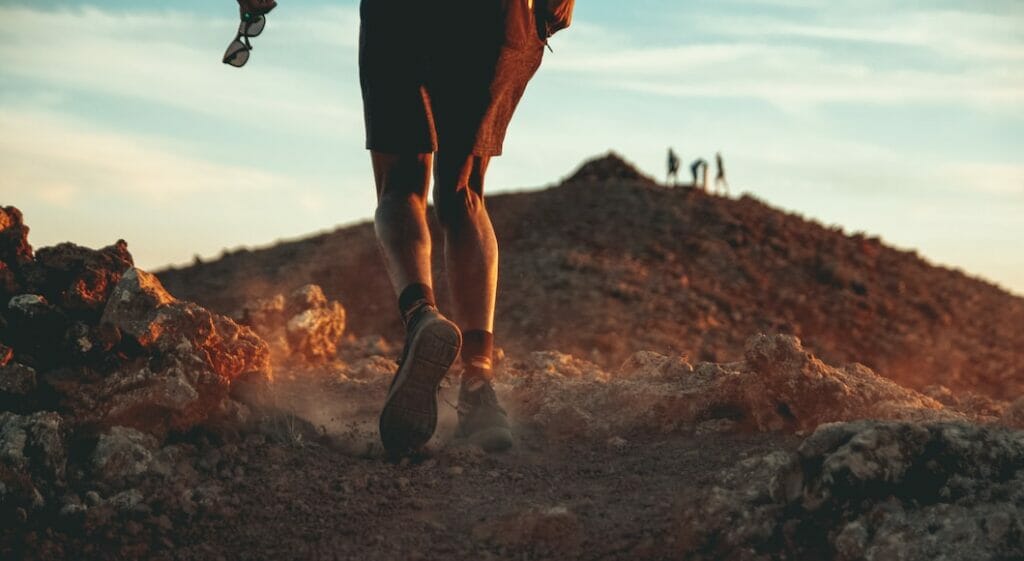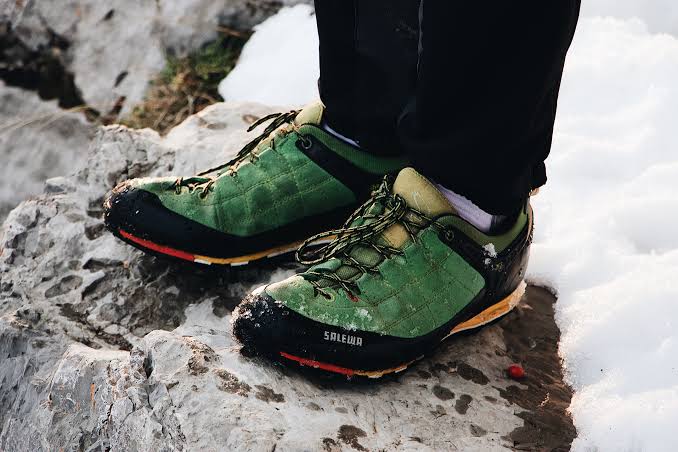How Long Does It Take To Break In Hiking Boots? No Pain All Gain
As an avid hiker, I’ve always been thrilled to embark on new adventures, seeking out breathtaking vistas and connecting with nature’s wonders. However, my enthusiasm was often dampened by the nagging discomfort of brand-new hiking boots.
I couldn’t help but wonder: How long does it really take to break in these rugged companions? As I hit the trails with blistered feet one too many times, I decided it was time to delve deeper into this common predicament.
Join me on a journey of exploration and discovery, as I recount my personal experience with breaking in hiking boots and share some valuable insights that helped me overcome this nagging problem, ensuring that every future hike is as comfortable and enjoyable as possible.

It is important to note that there is no magic number of miles that will guarantee a perfectly broken-in boot. Instead, the best way to break in hiking boots is to wear them gradually, and to pay attention to how they feel on your feet.
The number of miles it takes to break in hiking boots vary, depending on a number of factors, including the type of boot, the materials it’s made of, and the shape of your feet.
How Much Toe Room In Hiking Boots?
How Long Does It Take To Break In Hiking Boots?
Let me tell you an honest answer. Don’t worry about breaking of your hiking shoes. After just 2 to 3 hikes they will be your loyal companion.

But in general, most hiking boots start to feel more comfortable after 10-20 miles of hiking, but it also take up to 100 miles to fully break them in. This is because most hiking boots are made of leather or synthetic materials that need time to mold to the shape of your foot.
Material and Construction of Hiking Boots
Beyond just my foot size, the material and construction of hiking boots also play a pivotal role in the elusive quest for ultimate comfort.
Leather – The timeless classic, leather hiking boots are renowned for their durability and support. However, they often require a more extended break-in period due to their firmness.

Synthetic Fabrics – Modern advancements have brought about lightweight and quick-drying synthetic hiking boots. These boots tend to be more forgiving during the break-in process, offering a more comfortable fit from the get-go.
Waterproofing Membranes – Boots equipped with waterproof membranes like Gore-Tex provide invaluable protection against wet conditions. While these membranes enhance the boot’s functionality, they might require additional effort to break in fully.
Stiff vs. Flexible Soles – Hiking boots with stiffer soles offer excellent stability and support on rough terrains, but they can be initially rigid and less forgiving on the feet. Conversely, boots with more flexible soles may require less break-in time but might not provide the same level of protection on challenging trails.
Toe Boxes and Heel Cups – The shape and padding of the toe boxes and heel cups significantly impact the overall comfort of the boots. A snug but not overly tight fit in these areas can prevent painful blisters and discomfort during the break-in period.
Midsole Cushioning – The amount and type of cushioning in the midsole affect shock absorption and comfort during hikes. It’s crucial to find the right balance between cushioning and responsiveness based on personal preferences.
As I slipped my feet into my new leather hiking boots, I couldn’t help but notice their sturdy build and classic charm. Eager to hit the trails, I set out on a short hike, only to discover that my excitement was met with some resistance.

The firmness of the leather made each step feel like a battle, and my heart sank at the thought of weeks of discomfort ahead. Yet, I persevered, reminding myself that quality hiking boots are an investment in my outdoor experiences.
As days turned into weeks, I found myself marveling at the intricate differences in materials and construction that influence the break-in process. I learned that synthetic hiking boots, with their lightweight and forgiving nature, could be a more appealing choice for those seeking immediate comfort.
However, leather boots, despite their initial rigidity, promised unparalleled durability and robust support in the long run.
While the material and construction of hiking boots can influence the break-in period, I discovered that the most significant factor was my commitment to the journey.
Embracing the discomfort as part of the process, I slowly but surely molded my boots to fit my feet like a second skin. As the trails became my testing grounds, I realized that the effort invested in breaking in my hiking boots was rewarded with unparalleled comfort and support, allowing me to focus solely on the beauty of nature that surrounded me.
Foot Anatomy
I vividly recall a hiking trip with a group of friends, and as we started our trek, excitement mingled with apprehension about my brand-new boots. One of my friends, Sarah, who had hiked countless trails, seemed unperturbed by her newly acquired footwear.
Her boots, seemingly molded to her feet, moved with an effortless grace, as if they were old companions. In contrast, I couldn’t shake off the persistent pressure points that left me longing for my trusty old pair.

As I shared my experience with Sarah and the others, I came to realize that Sarah’s feet were somewhat narrower than mine, and her arches were different too.
It dawned on me that the breaking-in period is not just about the boots but also about how they conform to our unique foot anatomy.
Through further discussions with fellow hikers, I learned that some of them preferred a tighter fit from the outset, anticipating the boots to stretch and mold over time.
Others, like myself, felt more comfortable with a slightly looser fit, allowing the boots to adjust gradually. It became evident that understanding our individual foot characteristics was essential in determining the best approach to breaking in hiking boots.
Armed with this newfound knowledge, I decided to experiment with different lacing techniques and sock combinations to cater to my specific foot shape. It wasn’t an instant fix, but it allowed me to alleviate discomfort during the break-in process.
As I shared my insights with my hiking buddies, I saw them finding their unique ways of tackling this common predicament.
14 Best Hiking Boots For Men All Terrain in 2023
Foot shape and individual differences undoubtedly influence the breaking-in journey for every hiker. Embracing these differences and taking the time to understand our feet not only made the process more manageable but also led to a more enjoyable and pain-free hiking experience in the long run.
So, the next time you slip on a new pair of hiking boots, remember that it’s not just about the boots but about the beautiful dance between your feet and the terrain that lies ahead.
Types of trains and trails
In my opinion, the types of terrain and hiking conditions play a crucial role in determining how long it takes to break in hiking boots and how comfortable the overall hiking experience will be. Different terrains present unique challenges for hikers and their footwear, and understanding these factors can greatly influence the break-in process.

For instance, if I plan to hike on rugged and uneven trails with rocky surfaces, my hiking boots would need to provide ample ankle support and cushioning. In such conditions, a longer break-in period might be required to ensure that the boots conform to my feet and offer the necessary stability.
On the other hand, if I intend to hike on smoother, well-maintained trails, the break-in period might be slightly shorter. However, I must not overlook the importance of properly breaking in my boots, even in milder conditions, to prevent discomfort and potential foot injuries during the hike.
Moreover, weather conditions also come into play. If I’m planning a hike in wet or muddy areas, I’d need to consider the waterproofing capabilities of my boots. Waterproof boots may require some extra time to break in due to their specialized materials.
Overall, it’s essential to choose hiking boots that are well-suited to the specific terrain and conditions I’ll encounter during my adventures. Taking the time to break in the boots properly will not only ensure a more comfortable hike but also extend the lifespan of the footwear, allowing me to enjoy many more memorable journeys in the great outdoors.
Patience
Patience is a virtue often tested when breaking in hiking boots, but it is undeniably a crucial element of the process. As tempting as it may be to rush into long hikes with new boots, resisting the urge and allowing ample time for the breaking-in period is vital for a comfortable and injury-free hiking experience.
The materials used in hiking boots need time to adapt and mold to the unique contours of your feet, and this cannot be hurried. Pushing the limits too soon may lead to painful blisters, chafing, and unnecessary discomfort that can dampen your enthusiasm for future hikes.
By exercising patience, you give your feet the chance to adjust gradually to the boots, and you’ll notice the difference with each step. As you embark on shorter hikes and take the time to understand how your boots respond to different terrains, you’ll begin to feel the subtle improvements in fit and flexibility.
Embracing this process allows you to forge a stronger connection with your hiking gear, and in turn, it enhances your overall trekking experience.
Remember that every individual and pair of hiking boots is unique, and the break-in time may vary. While your hiking buddy’s boots may have felt comfortable after a few outings, yours might take a little longer, and that’s perfectly normal.
The key is to trust the process, be patient with yourself and your gear, and appreciate the journey of making your hiking boots an extension of your adventurous spirit.
So, as you lace up those new hiking boots and set off on the trails, embrace the art of patience. In doing so, you’ll not only ensure greater comfort and joy during your current hike but also set the stage for countless more adventures ahead.
After all, the mountains and wilderness will always be there, waiting to be explored, and with the right amount of patience, you’ll conquer them all with happy, blister-free feet.
What Color Hiking Boots Should I Get
Step-by-step Guide On How To Break In Hiking Boots
Breaking in hiking boots is a daunting task, but it is essential for a comfortable and safe hiking experience. Here is a step-by-step guide on how to break in hiking boots:
1.Start Slowly
The first step to breaking in your hiking boots is to start slowly. Don’t attempt a long hike right away as it can cause discomfort and blisters.
Instead, wear your boots around the house or for short walks to allow your feet and boots to get used to each other.

2. Sretching
If your boots feel too tight, try stretching them. Use a shoe stretcher or stretch them out with your hands. Place your hands inside the boot, hold the toe area, and gently pull upwards. Repeat this several times until you feel the material loosen up.
How Often Should You Replace Your Hiking Boots?
3. Use Foot Powder
To avoid blisters, use foot powder or an anti-chafing cream on your feet before wearing your boots. This will reduce friction and keep your feet dry.
4. Break Them in Gradually
As your boots start to feel more comfortable, gradually increase the duration of your walks or hikes. Remember to take your time and don’t push yourself too hard.
5. Use a Wet Cloth
If your boots are made of leather, using a damp cloth to soften them is a good option. Dampen a cloth and rub it over the boots to make them more flexible.
6. Use Inserts
If you have flat feet or high arches, using inserts help to make your boots more comfortable. You can buy inserts specifically designed for hiking boots, or you can use over-the-counter insoles.
7. Check the Lacing
Make sure your boots are laced correctly to prevent any discomfort or rubbing. Use different lacing techniques to adjust the tightness in different areas of your foot.
8. Petroleum Jelly
If you are in a hurry to break in your hiking boots, you can try a few tricks to speed up the process. One trick is to apply a thin layer of petroleum jelly or leather conditioner to the boots before walking.
This softens the leather and speed up the breaking-in process. However, you should be careful not to overdo it as too much conditioner can cause the boots to become too soft and lose their shape.
By following these steps, you can break in your hiking boots effectively and comfortably. Remember to take your time and wear them gradually, and you’ll be ready to hit the trails with confidence in no time.
14 Best Waterproof Hiking Boots Under $100 (Buying Guide )
Signs Shows That Your Hiking Boots Are Ready
Breaking in a new pair of hiking boots can be a daunting task, but the good news is that there are clear signs that your boots are broken in and ready for long hikes.
By paying attention to these signs, you can ensure that your boots are comfortable and supportive, reducing the risk of injury and allowing you to fully enjoy your hiking adventures. Here are some clear signs that your hiking boots are broken in and ready for long hikes:
1. They feel comfortable
The most obvious sign that your hiking boots are broken in is that they feel comfortable on your feet. Your boots should no longer feel stiff or tight, and you should be able to move your toes and flex your foot without any discomfort.

2. They fit well
A broken-in hiking boot should fit your foot snugly without feeling tight or constricting. Your heel should stay in place when you walk, and there should be no slippage or rubbing in the toe box or on the sides of the boot.
3. No hot spots or blisters
If your boots are fully broken in, they should no longer cause hot spots or blisters on your feet. If you experience any discomfort or pain while wearing your boots, it could be a sign that they are not yet fully broken in.
4. Soles are flexible
A broken-in hiking boot will have a flexible sole that allows your foot to move naturally. When you flex your foot, the sole should bend with it, rather than feeling rigid or stiff.
5. They are broken in evenly
When a hiking boot is broken in correctly, it should conform to the shape of your foot evenly. If you notice that there are certain areas of the boot that are still stiff or uncomfortable, it could be a sign that the boot is not yet fully broken in.
There are clear signs that your hiking boots are broken in and ready for long hikes. By paying attention to these signs, you can ensure that your boots are comfortable, supportive, and provide the traction and stability you need to enjoy your hiking adventures.
Can You Wear Hiking Socks For Skiing : Surprising Truth
Do Different Types Of Hiking Boots Require Different Breaking-in Periods?
Yes, different types of hiking boots require different breaking-in periods. The length of time it takes to break in hiking boots depends on the type of boot, the materials used, and the purpose of the hike.
Hiking boots are broadly categorized into three types – lightweight hiking boots, midweight hiking boots, and heavyweight hiking boots.
Lightweight hiking boots
These boots are made of lightweight materials and have flexible soles that make them easy to break in.
They generally take a shorter time to break in, typically 10-20 miles of walking. If you are planning a day hike or a short backpacking trip, lightweight hiking boots are a good choice.
Midweight hiking boots
These are more substantial and stiffer than lightweight boots, and they take longer to break in. They are designed for longer hikes and backpacking trips and can carry heavier loads.
The breaking-in period for midweight hiking boots is around 20-30 miles of walking. It is recommended to wear these boots on a few shorter hikes before taking them on a more extended hike.
Heavyweight hiking boots
These are the most substantial type of hiking boots and are designed for extreme hiking and mountaineering. They are made of sturdy materials and have thick soles that offer more support and protection.
Due to their rigid structure, heavyweight hiking boots take the longest time to break in. It can take up to 40-50 miles of walking to break them in fully. It is important to note that heavyweight hiking boots are not suitable for day hikes or short backpacking trips.
Are Hiking Shoes Suitable For Construction Work?
Can I Speed Up The Breaking-in Process Of My Hiking Boots?
Remember, there are ways to speed up the breaking-in process, but it is still important to take the time to gradually break in your hiking boots to avoid discomfort or foot-related problems on your hiking trip. Rushing the process leads to pain, blisters, or even injury, which can be detrimental to your hiking experience.
Hike With Ease : How To Make Hiking Backpack Lighter
Conclusion
Breaking in a new pair of hiking boots can be a time-consuming process, but it’s essential to ensure that your boots are comfortable and provide the support and stability you need for your hiking adventures.
With these tips, you can enjoy your hiking adventures with comfortable and supportive boots, reducing the risk of injury and allowing you to fully immerse yourself in the beauty of nature.
Will Hiking Shoes Wear Out Faster If I Use Them For Everyday Wear?


